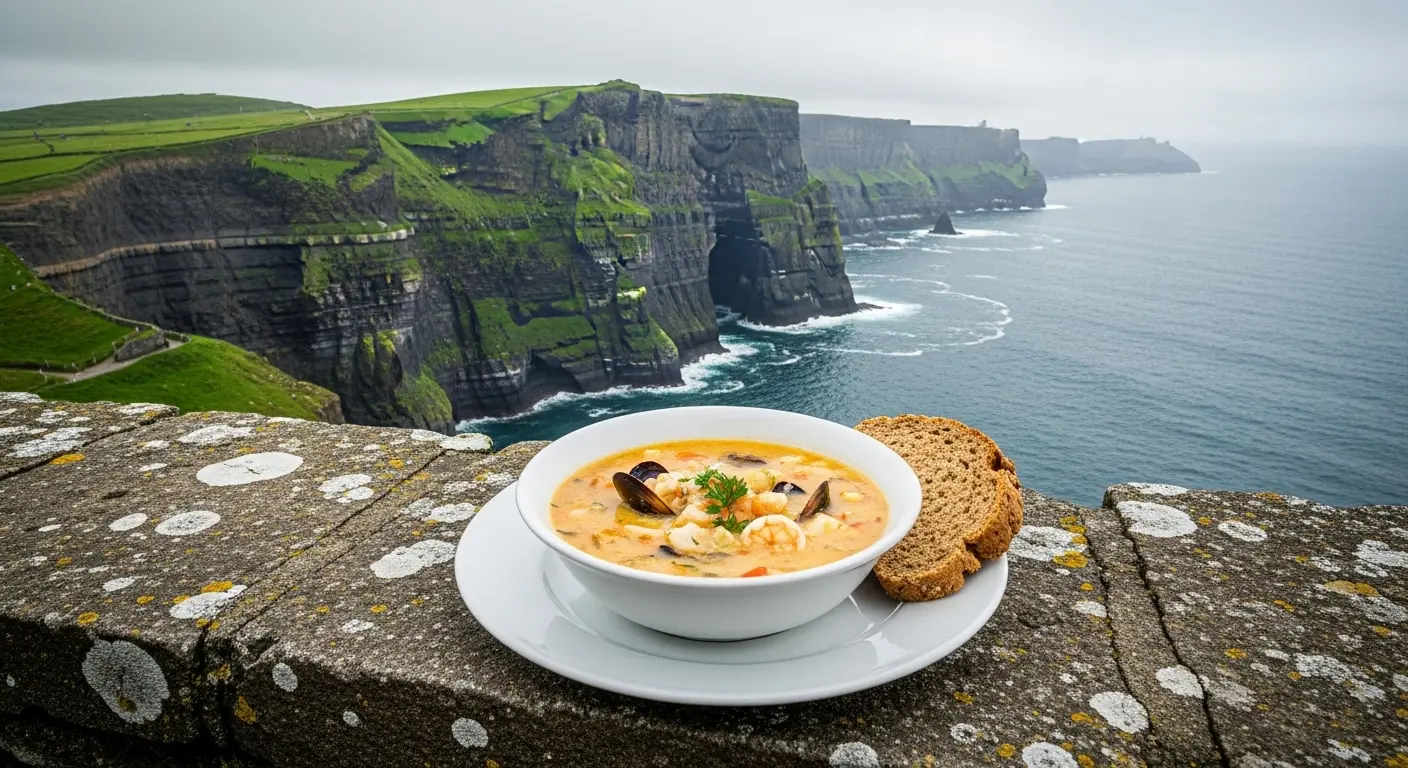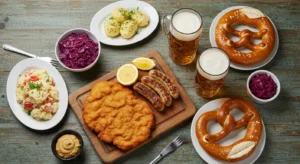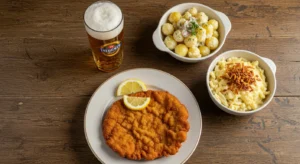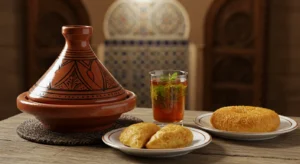Table of Contents
More Than Corned Beef: Your Warm Invitation to Irish Food
Let’s be honest. When you think of Irish food, what comes to mind? For many, it’s a hazy picture of a green-tinted plate featuring corned beef, cabbage, and maybe a pint of Guinness. It’s a persistent image, but I’m here to tell you it’s one that barely scratches the surface.
The real story of Irish cuisine is one of humble ingredients transformed by necessity, a deep connection to the land and sea, and a modern culinary revolution that’s breathing new life into ancient traditions. It’s food that doesn’t just feed the body; it comforts the soul. It’s the taste of resilience and welcome.
Having spent a significant amount of time exploring Ireland from the bustling pubs of Dublin to the remote coastal villages of Kerry, I’ve been lucky enough to eat my way through the real Ireland. I’ve tasted the difference between a stew made with care in a country kitchen and a mass-produced version. I’ve seen firsthand how a new generation of chefs and food producers are honoring their past while boldly looking to the future.
So, consider this your personal guide. We’re going to move beyond the clichés and dive into the heartwarming, delicious, and surprisingly diverse world of Irish food. You’ll learn about its foundational pillars, the dishes you absolutely need to try, and why now is the most exciting time in history to taste Ireland.
The Roots of the Irish Table: A Story Written in the Soil
To truly “get” Irish food, you have to understand its history. It’s not a cuisine built on exotic spices or complex techniques. For centuries, it was built on survival. Ireland’s temperate, damp climate is perfect for growing grass, which in turn is perfect for raising livestock. This simple environmental fact is why dairy and meat, particularly beef and pork, have been central for millennia.
The humble potato, introduced in the late 16th century, gets a lot of attention, and for good reason. It became a staple that allowed the population to grow. But the tragic Great Famine of the 1840s, a period of mass starvation and emigration caused by potato blight, left a profound scar on the national psyche. It shaped a frugal, “waste not, want not” approach to cooking that prized simplicity and heartiness above all else.
This history forged a cuisine that is fundamentally honest. It’s about taking a few high-quality ingredients and treating them with respect. It’s the reason you’ll find some of the best dairy products in the world there; the butter is richer, the cream is thicker, and the cheese is incredible. It’s a direct result of that lush, rain-fed grass.
The Pillars of a Traditional Irish Kitchen
Before we get to the specific dishes, let’s talk about the building blocks. These are the ingredients and elements you’ll find repeated in classic Irish cooking.
- The Holy Trinity of Proteins: Beef, lamb, and pork. You’ll find them in stews, as roasts, and in classic breakfasts.
- The Bounty of the Sea: Being an island, Ireland is surrounded by some of the best fishing grounds in the world. Salmon, cod, mackerel, and Dublin Bay Prawns (langoustines) are staples you can’t miss.
- Dairy, the Golden Child: Irish butter is a world-class product. Buttermilk is used for tenderizing and leavening in soda bread. And a slice of sharp, creamy Irish cheddar with an apple is a perfect snack.
- The Humble Vegetable Pantry: Potatoes, of course, in countless varieties and preparations. But also cabbage, onions, leeks, and carrots, which form the vegetable backbone of many a stew and soup.
Must Try Irish Dishes (That Aren’t Just Corned Beef)
Alright, let’s get to the good part, the food you need to seek out.
The Iconic Irish Stew
Forget any vague notion of a stew with a brown gravy. A true, traditional Irish Stew is a beautiful lesson in simplicity. It was originally a peasant dish, made with the most readily available, inexpensive ingredients. The classic version uses tender lamb (or mutton), potatoes, onions, and sometimes carrots, all slow-cooked in a light broth until the meat is falling apart and the potatoes have thickened the liquid into a comforting, savory blanket. There are no thickeners, no fancy herbs, just the pure, melded flavors of its few components. It’s the taste of home.
The Perfect Pair: Irish Soda Bread & Irish Stew
You simply cannot have a stew without a thick slice of soda bread slathered in good Irish butter. This bread is a testament to Irish ingenuity. Without easy access to yeast, bakers used bicarbonate of soda (baking soda) as a leavening agent, reacting with the acidity of sour milk or, more commonly today, buttermilk.
The result is a dense, hearty, slightly tangy bread with a craggy top and a firm crust. It’s the ultimate tool for mopping up every last bit of stew from your bowl. Every family has their own recipe; some add a handful of oats, others a sprinkle of seeds. It’s a living, breathing food tradition.
The Full Irish Breakfast: A Plate of Epic Proportions
This is not a light, continental affair. The “Full Irish” or “Fry” is a hearty meal designed to fuel a day of hard work. While it shares some DNA with the English breakfast, it has its own distinct personality. You can expect:
- Rashers: This is key. These are not American-style crispy bacon strips. Irish rashers are a back bacon, closer to Canadian bacon, but often with a delicious ribbon of fat.
- Pork Sausages: Plump, herby, and uniquely Irish.
- Black and White Pudding: Don’t let the name fool you; this isn’t a dessert. Pudding is a type of sausage. White pudding is made from oats, suet, and pork. Black pudding includes blood, which gives it a dark color and a rich, iron-like flavor. It’s a must-try for the adventurous eater.
- Fried Eggs
- Grilled Tomatoes and Mushrooms
- Beans (sometimes)
- And of course, soda bread or fried potato bread.
It’s a ritual, a weekend treat, and a legendary cure for a late night.
Seafood Chowder: A Taste of the Atlantic
If you want to taste the Irish coast, order a bowl of seafood chowder. This is where the quality of the ingredients truly shines. A creamy, silky broth is packed with fresh salmon, firm white fish, plump prawns, and mussels. It’s always finished with a generous sprinkle of fresh parsley. Served with, you guessed it, brown soda bread, it’s a meal you’ll dream about long after you’ve left.
The Modern Irish Food Renaissance
This is the most exciting part of the story. Over the last 20 to 30 years, Ireland has undergone a culinary transformation. There’s a powerful “farm to table” movement, but in Ireland, it feels less like a trendy label and more like a return to common sense.
Chefs are partnering directly with local farmers, cheesemongers, and fishermen. You’ll find menus proudly listing the names of the farms where the beef was raised or the bays where the oysters were harvested. This has led to a cuisine that is both globally influenced and deeply rooted in Irish soil.
Think of dishes like Carrageen Moss (a native seaweed) panna cotta, dry-aged Irish beef with a wild garlic pesto, or artisanal Irish cheese boards that rival anything from France. Organizations like Bord Bia (the Irish Food Board), have been instrumental in promoting quality and origin, helping to build a truly authoritative and trusted food ecosystem.
FAQs: Your Irish Food Questions, Answered
Q: Is corned beef and cabbage actually Irish?
A: It’s a complicated part of the diaspora story. While cured beef was eaten in Ireland, the specific dish of “corned beef and cabbage” was popularized by Irish immigrants in America. In Ireland, bacon and cabbage were (and are) the more traditional pairing. The immigrants found that Jewish corned beef from their neighbors in New York was a tasty and affordable substitute for the bacon back home.
Q: What’s a classic Irish dessert?
A: Look for Apple Cake or Rhubarb Tart, often made with locally grown fruit. Another classic is Bailey’s Chocolate Cheesecake, a more modern but utterly beloved treat.
Q: I’m visiting Ireland. Where should I eat to get the real experience?
A: Don’t just eat in fancy restaurants. Make sure to visit a traditional pub known for its food (many have excellent kitchens), a local farmers’ market (like the English Market in Cork), and a chipper (a fish and chip shop) for a perfectly battered piece of cod.
Q: What should I drink with my meal?
A: A perfectly poured pint of Guinness is a classic for a reason; its creamy bitterness pairs wonderfully with stews and beef. But also don’t sleep on Irish whiskey, either neat or in an Irish Coffee, or the fantastic local craft cider.
A Final Slice of Soda Bread
Irish food has journeyed from mere sustenance to a source of national pride and international acclaim. It’s a cuisine that tells a story of its people, a story of hardship, resilience, and a profound connection to a beautiful, green land. It’s unpretentious, generous, and deeply satisfying.
So, the next time you have the chance to enjoy a bowl of Irish stew or bake your own loaf of soda bread, remember you’re not just eating a meal. You’re tasting a piece of history, warmed by a modern spirit of innovation and a timeless, world-famous welcome.




